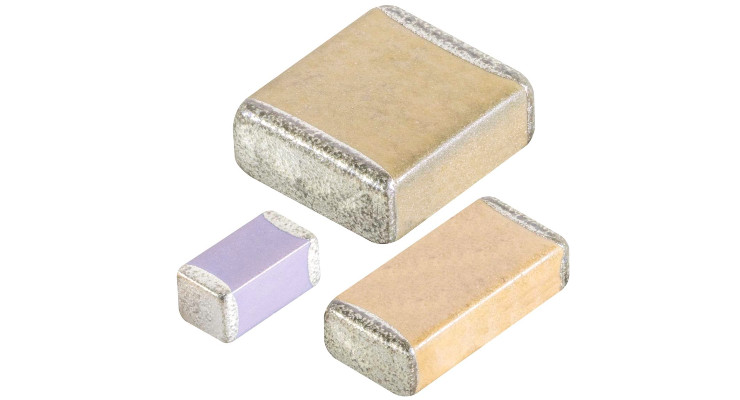Rich Bestafka, Key Account Manager—Medical, Knowles Precision Devices10.12.20
As medical technology rapidly advances, electronics design engineers are faced with the never-ending demand to increase functionality, reduce size, and improve reliability. Further, strict regulatory guidelines hold their designs to a high standard at the device level and the component level. Even the smallest electronic building blocks must confront the complexities that come with high-reliability applications such as medical devices. There are a number of critical components that enable or ensure the reliable performance of medical implantables and other life-sustaining devices or diagnostic tools. In this article, we’ll discuss a pair of high-impact, specialty capacitors.
High-Reliability Capacitors
When assessing the range of critical components that contribute to the overall reliability and longevity of medical devices, capacitors are just one of the many. Strict component-level guidelines place more weight on reliability grade, size, and durability over other common parameters of importance in consumer electronics.
Medical equipment is highly scrutinized for quality and safety, throughout development and manufacturing, to ensure success when interacting with the human body. For example, with implantable medical devices, one of the main goals is to minimize the need for invasive surgeries; developing devices smaller in size and higher in reliability and service life contributes to the solution at a foundational level.
This attention to detail extends to every component with specifications, including MIL-PRF-55681 and MIL-PRF-123 for capacitors. Regulatory bodies, such as the International Organization for Standardization (ISO) and the U.S. Food and Drug Administration (FDA), require medical device manufacturers meet this SCD specification to maintain the highest level of reliability at all phases of component development and production.
The same level of scrutiny applies to component testing. High-reliability capacitors should be 100-percent electrically inspected and burned-in at elevated voltage and temperature levels to precondition the parts and comply with the established performance criteria. Testing requires specialized equipment, tooling, and significant time investment from the quality assurance engineering team. Manufacturers require extensive resources to comply, but their efforts ultimately protect patients.

Cochlear implants are one of many applications where a high-reliability capacitor is important to a system that can improve quality of life for patients.
Aside from implantables, the demand for portable and wearable technology has increased as medicine begins to move away from conventional settings. Traditional benchtop devices are increasingly wearable and implantable to improve quality of life for patients. However, that means manufacturers need to offer extensively tested high-reliability components at very small sizes. For example, a high-reliability capacitor is one of the many important components that allow a cochlear implant to provide a sense of sound to deaf or severely hard-of-hearing patients. In smaller size ranges like this, using a more compact, high-reliability product is required.
Non-Magnetic Capacitors for MRI Technology
Magnetic resonance imaging (MRI) technology is helpful in identifying a number of potentially life-threatening health concerns. In short, to do this, the MRI machine uses a strong magnetic field and computer-generated radio waves to produce cross-sectional images of the body. Even the smallest amount of magnetism inside an MRI scanner can disrupt the field’s homogeneity (or uniformity).
The homogeneity of the magnetic field significantly impacts the quality of the MRI image output. Low-quality images may lead to a mistaken diagnosis or misguided treatment selections. It’s important for medical device manufacturers to look for components, including fixed capacitors, trimmer capacitors, inductors, and connectors, that use high-purity metals that exhibit no measurable magnetism.
To minimize any disruptions, it’s vital suppliers have strict traceability and testing regimens for components of all sizes. For example, many capacitors are designed with a nickel barrier finish to maintain solderability; however, nickel’s magnetic properties disqualify the capacitor from being used in imaging applications. Similarly, commercial brass, another commonly used material, is also not acceptable for these applications.
This amount of care on the component level prevents image distortion and minimizes the need for image correction. As a result, clinicians can reliably investigate and diagnose patients without the need for more invasive procedures.
Conclusion
In mission-critical medical applications, device failure comes at a high cost. Selecting the right components can remove some of the uncertainty and lessen the possibility of error. At the end of the day, making smart choices, even at the smallest component level, shows a commitment to the healthcare professionals and patients who rely on your products.
Rich Bestafka is a key account manager—medical at Knowles Precision Devices. He has over 20 years of experience working in various aspects of the electronic components industry and currently oversees medical key accounts for the company.
High-Reliability Capacitors
When assessing the range of critical components that contribute to the overall reliability and longevity of medical devices, capacitors are just one of the many. Strict component-level guidelines place more weight on reliability grade, size, and durability over other common parameters of importance in consumer electronics.
Medical equipment is highly scrutinized for quality and safety, throughout development and manufacturing, to ensure success when interacting with the human body. For example, with implantable medical devices, one of the main goals is to minimize the need for invasive surgeries; developing devices smaller in size and higher in reliability and service life contributes to the solution at a foundational level.
This attention to detail extends to every component with specifications, including MIL-PRF-55681 and MIL-PRF-123 for capacitors. Regulatory bodies, such as the International Organization for Standardization (ISO) and the U.S. Food and Drug Administration (FDA), require medical device manufacturers meet this SCD specification to maintain the highest level of reliability at all phases of component development and production.
The same level of scrutiny applies to component testing. High-reliability capacitors should be 100-percent electrically inspected and burned-in at elevated voltage and temperature levels to precondition the parts and comply with the established performance criteria. Testing requires specialized equipment, tooling, and significant time investment from the quality assurance engineering team. Manufacturers require extensive resources to comply, but their efforts ultimately protect patients.

Cochlear implants are one of many applications where a high-reliability capacitor is important to a system that can improve quality of life for patients.
Non-Magnetic Capacitors for MRI Technology
Magnetic resonance imaging (MRI) technology is helpful in identifying a number of potentially life-threatening health concerns. In short, to do this, the MRI machine uses a strong magnetic field and computer-generated radio waves to produce cross-sectional images of the body. Even the smallest amount of magnetism inside an MRI scanner can disrupt the field’s homogeneity (or uniformity).
The homogeneity of the magnetic field significantly impacts the quality of the MRI image output. Low-quality images may lead to a mistaken diagnosis or misguided treatment selections. It’s important for medical device manufacturers to look for components, including fixed capacitors, trimmer capacitors, inductors, and connectors, that use high-purity metals that exhibit no measurable magnetism.
To minimize any disruptions, it’s vital suppliers have strict traceability and testing regimens for components of all sizes. For example, many capacitors are designed with a nickel barrier finish to maintain solderability; however, nickel’s magnetic properties disqualify the capacitor from being used in imaging applications. Similarly, commercial brass, another commonly used material, is also not acceptable for these applications.
This amount of care on the component level prevents image distortion and minimizes the need for image correction. As a result, clinicians can reliably investigate and diagnose patients without the need for more invasive procedures.
Conclusion
In mission-critical medical applications, device failure comes at a high cost. Selecting the right components can remove some of the uncertainty and lessen the possibility of error. At the end of the day, making smart choices, even at the smallest component level, shows a commitment to the healthcare professionals and patients who rely on your products.
Rich Bestafka is a key account manager—medical at Knowles Precision Devices. He has over 20 years of experience working in various aspects of the electronic components industry and currently oversees medical key accounts for the company.

























